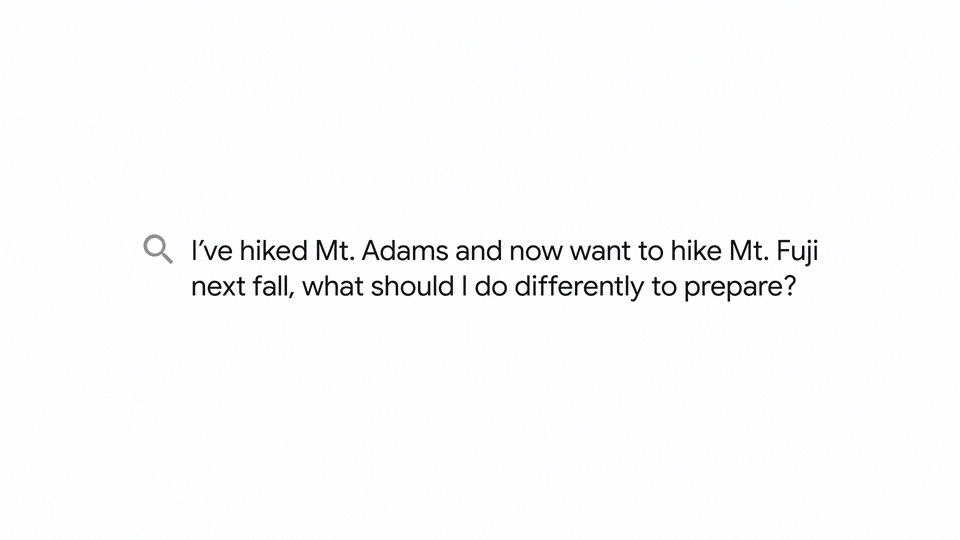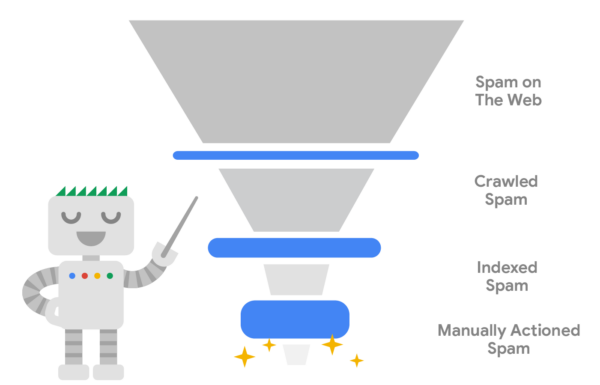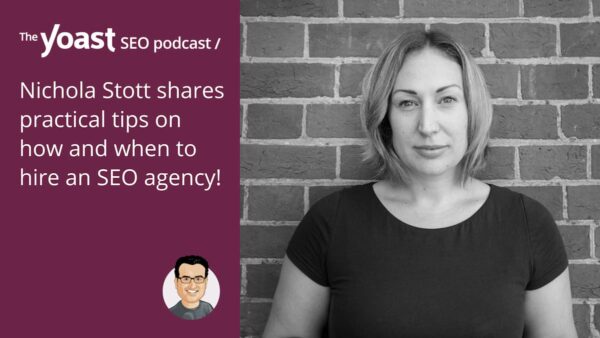This month, Google held their annual I/O conference, an event at which they announce new product releases and other interesting stuff. They introduced us to MUM, their new language model and the next step in understanding online content. But meeting (their) MUM wasn’t all. There was lots of SEO news in May 2021 and our resident experts Joost and Jono discussed all of it in our monthly webinar. You can find the highlights in this post!
Watch the May 2021 SEO news webinar
In this post, we’ll discuss the highlights of this month’s SEO news webinar. If you’d rather just (re)watch the webinar, you can find the video right here. And don’t forget to register for the next edition of our SEO news webinar on the 29th of June, 2021! We hope to see you there.
The latest Google news
Let’s start with the Google news that came out this month. In addition to their annual Google I/O conference, Google also shared a report on webspam and some advice on optimizing images. Which means we have lots of news to get to, so let’s dive in.
Meet Google’s MUM, their new language model
At Google I/O 2021 the newest language model was announced: Google MUM. MUM, which is short for Multitask United Model, is Google’s next step in understanding natural language. This model is 1000 times more powerful than BERT, a language model that proved a breakthrough in 2019. The power behind MUM is that it can multitask — and it can also generate content. The idea is that it can read text, understand the meaning, form deep knowledge about the topic, use video and audio to enrich that, get insights from over 75 languages and translate those findings into multi-layered content that answers complex questions.

To elaborate, the idea is that Google wants to move away from ranking the best page for a certain keyphrase. It wants to take pieces of relevant information across different pages in different formats (and different languages) and offer users a tailored solution. Of course, we’ll need to see how MUM works when it launches, but the important takeaway is similar to what we already said. You need to make sure your content is focused on solving user problems. Help them research, answer their questions, provide advice, opinions, etcetera. Do more than just compete for that one keyword you want to rank on. You need to construct useful content experiences. We know this is a big ask, but it is the direction that search engines are moving in.
Webspam report: An increase in detecting spam
Spam is as old as the internet. Scratch that, spam is even older. Online spam is as old as the internet. And although spam is still a big part of our reality, Google mentions a 60% increase in spam detection since 2019 in their latest Webspam Report. They elaborate to tell us that AI helps revolutionize their approach to fighting spam. By building a very own spam-fighting AI that catches both known and new spam trends, they’ve been able to improve their detection capability by more than 50%. And removed most of the hacked spam from search results.

The interesting thing to mention here is that not everybody realizes that a large chunk of webspam is SEO-related. A lot of it is actually people trying to produce lots of low-quality links and massive networks of sites that offer auto-generated content. There are even websites being hacked so that these hackers can inject links back to their own networks and content. All of these networks that are focused on this bad practice are connected with other networks and this means that we end up with millions of pages of spam.
The moral of the story is to keep your site safe and secure. Keep your plugins and themes updated, get reliable hosting and make sure to follow best practices when it comes to the site health report in WordPress. This report can actually help you a lot. Google Search Console is also quite good at spotting any issues that you should take action on. You don’t want to be one of those hacked websites and you don’t want to be one of those pages that Google dismisses because they view it as spam.
Video SEO: a few best practices for ecommerce sites
Google also listed a set of best practices for videos on ecommerce sites. One interesting takeaway is that you should make the video the main focus of a page and try to keep it to one video per page. Another takeaway is that if you have videos, you need to think about how people shop and research online. Often video plays an important role in the research stage where people explore their options, potential solutions and competitors. It doesn’t make sense to create videos that just try to convince people to buy your product. You want to help solve their problem, compare, and be an expert that educates them about more than your product. Make people remember you and your brand as they go through that journey. Read more in our blog post on how to optimize your video pages.
If you have videos on your site, or want to get started with it, our Video SEO plugin can help you get your videos in the search results. It also includes the right structured data to make your video eligible for Google’s video carousel and the Video tab search results.
Optimizing your images
Google’s John Mueller tweeted an interesting thread with some advice on how to optimize your images without losing your image search rankings. In addition to uploading your image in an optimal format and the right size, he mentioned another best practice. Redirecting your image URL when you change it to another one:
So when you change an image on your product page, for example, don’t forget to redirect the original image to the new one. As the original image may still be clicked on in Google’s Image Search, which can be a good source of traffic. If you’re a user of WordPress, the redirect manager in our Premium plugin can help you redirect page URLs and image URLs.
Google’s Shopping Graph
Google Shopping gives us more insight into the Shopping Graph, a model that provides users with more information about products and it’s sellers. Essentially, it comes down to this. Google asks website owners to mark up their products with structured data. This structured data tells Google all the necessary information about their products, helping them understand what’s relevant to show to their users. This helps them determine what results to show, and it helps them present these products in a richer way. What this means for you, is that you need to consider how you’re going to stand out. As most people tend to filter their results on something like price, proximity or another specific need.
But Google Shopping now also provides users with more ways to shop by integrating with Shopify. If you are running a Shopify store, you can now have all of your product imagery show up on Google. This makes it quite attractive to have your shop on Shopify, as you won’t have to figure anything out yourself. It’s definitely worth looking into if you’re (interested in) using Shopify to sell your products online.
In other news
Shopping directly in Pinterest
In other related news, Pinterest is also expanding on its integration with Shopify. This integration gives 1.7 million merchants the ability to turn products from their e-commerce store into shoppable pins. What’s interesting about this is that we’re seeing much of the product discovery, validation and transaction process taking place within these kinds of ecosystems. It’s a good reminder that more and more of this journey is happening out there, away from your website. Without the need for people to go to your website to make a purchase. This means that, although you should always make sure that your website and checkout process works properly, you should also focus on these platforms that can increase your sales in other ways.
You need to compete on different platforms, that fit your brand and products. And you need to work on consistent branding across these platforms, as these engage your customers in lots of other ways.
Meet the Schema Markup Validator
A while back, Google announced they were going to kill the Structured Data Testing Tool. As lots of people used this tool, Schema.org took up the mantle as the new provider for a similar testing tool. Meet the Schema Markup Validator, which is a bit simpler than other Google tools that tell you whether you’re eligible for rich results. This new tool just tells you if your structured data is valid. Having separate tools for this is great, as you can decide which tool fits your need and it opens up Schema.org to more adoption, other than viewing what rich results you’ll get in Google.
The state of link building
Aira, a digital SEO marketing agency from the UK, is run by Paddy Moogan. A name that some of you might have heard before. In their annual report on The State of Link Building 2021, they look at different aspects of link building. What works, what’s changing, what experts recommend and what tools can help you with your link building. It’s a great resource that debunks legacy bad practices and tells you what to work on. Make sure to give it a read if you want to find out more about link building.
Rotting links
To stay on the topic of external links, there was a tweet by Jonathan Zittrain who (together with the New York Times) did research into link rot. Which doesn’t sound appealing, but is a serious issue that you should give some attention to. They found out a lot of the external links that were added over time to articles on nytimes.com no longer work. These are now rotted and unfortunately, this can happen in several ways.
In his thread on Twitter, Jonathan gives a whole lot of examples of how this can go wrong. They also mention some solutions in there, but unfortunately, there isn’t one best solution to fix this. Pages get deleted and you can’t always keep up with that. You can audit your own content every once in a while and check if your outgoing links are still going to the right page. Link rot will remain a problem, especially as the web gets bigger and older.
The latest WordPress news
Support for WebP images in WordPress
For a bit of fun WordPress news, native support for WebP image files is now coming to WordPress. This is great, because if you have the choice between formats then WebP is the way to go. This helps you make your images smaller and speed up your pages. The next version of WordPress will support WebP, so this will make it possible to add WebP images to your Media Library in the backend!
Openverse: a way to honor creative licenses
Automattic, the company run by Matt Mullenweg, bought the Creative Commons Search engine and donated it to the WordPress project. This means that there will be an automatic image search engine in WordPress soon, where you can search for images that are free to use. This will help a lot of WordPress users find and use images that they’re allowed to, without any complications when it comes to creative licenses. A win for both WordPress users as the people who own visuals being used online.
The bigger picture here is that this is part of a new project named Openverse. A project that has the potential to become more than a media search engine and bring together more open source platforms. Things like this make it easier to publish content, make connections and keep everything open for everyone.
The latest Yoast news
Quite some interesting news this month, don’t you think? We’ve also done a few new things at Yoast that we would love to mention.
New plugin releases
Our latest release, Yoast SEO 16.3, has a few structured data improvements. Including a cool new feature that helps you expand the Schema about yourself quite a bit. If you have Yoast SEO Premium, simply go to your profile where you can now fill in more information about yourself. This can be useful, especially if you have a knowledge graph showing up for your name. Some of the information that you provide here is literally used in that knowledge graph.
We also released a new version of our WooCommerce SEO plugin which now features a product snippet preview. It takes all the data from your product page (price, availability, rating, etc) and gives you a overview of that in the snippet preview. If you have WooCommerce and Yoast SEO, but you’re not seeing this preview at the moment, then you might be missing our WooCommerce SEO plugin which powers all of this.
5 years of writing readable content with Yoast SEO
We had a celebration this month, as the readability analysis in Yoast SEO turned 5 years old. Five years ago, nobody was really talking about readability in the SEO world. So, this anniversary is a great moment to talk about the importance of readability. We did an interview with our CEO Marieke and Irene on 5 years of writing readable content with Yoast SEO. And we dived a bit deeper into the readability checks in Yoast SEO with our linguistic team. Readability is and will always remain important in reaching a larger audience. As we always say: it’s not about dumbing down, it’s about opening up your content.
Our latest podcasts
In addition to our monthly webinar, we also do a few podcasts every month. During these podcasts, Joost talks to someone from the SEO or WordPress world about their expertise. In our latest podcast, we had Nichola Stott who tells us more about running an SEO agency and when you should consider hiring one.

Before that, Joost talked to Marieke van de Rakt, our very own CEO at Yoast. In this podcast, Marieke tells us more about the importance of readability, product marketing and leading Yoast. This is definitely a podcast you don’t want to miss.
Lastly, we did a podcast with Kristopher Jones a few weeks ago, in which he talks about entrepreneurship, investments and his interest in e-commerce. Make sure to give that one a listen or check out all of our podcasts if you’re wondering who else Joost has spoken to. We add a new one every two weeks!
Apply for our Diversity Fund
At Yoast, we care deeply about diversity. That’s why we created the Diversity fund a few years ago. A fund that makes it possible for more people to attend events. However, as these events now often take place online, we’ve had to think of another focus for our fund.
That’s why we’re looking for projects that benefit the diversity of WordPress. This can range from teaching a group of people anywhere in the world how to use WordPress to writing patches for Core. As long as your project contributes to making WordPress a better or more diverse place. If you have a project that does just that, apply for the Diversity fund and apply before the 31st of May, 2021!
That was the SEO news in May 2021
That was it for this month’s highlights in SEO news. If you want to join us for the next webinar, you can! For free! Just make sure to sign up for our next webinar on the 29th of June, 2021. Like every month, Joost and Jono will discuss the latest news in SEO, WordPress and other interesting news. It also gives you the opportunity to ask them any question you have. We hope to see you there!
Read more: SEO news in April 2021: More time for your Core Web Vitals »
The post SEO news in May 2021: Google introduces a new language model appeared first on Yoast.
 John
John 
